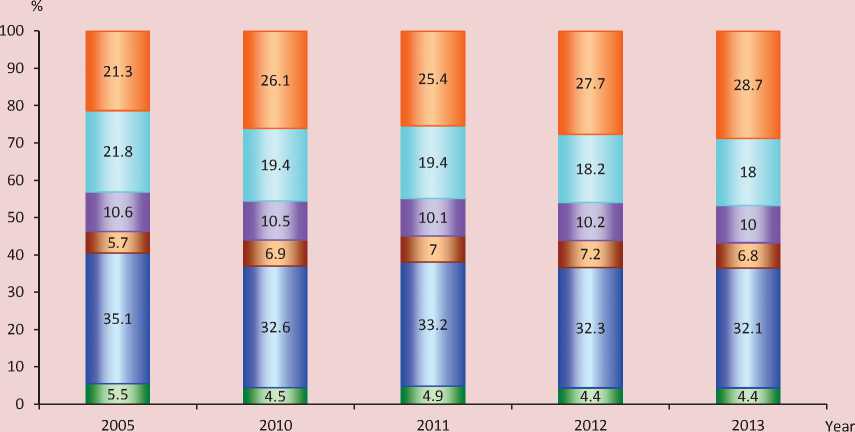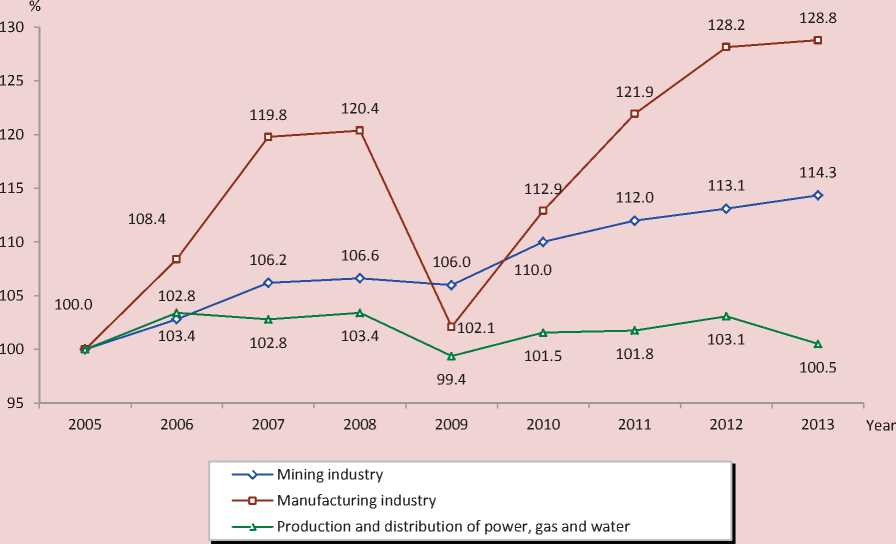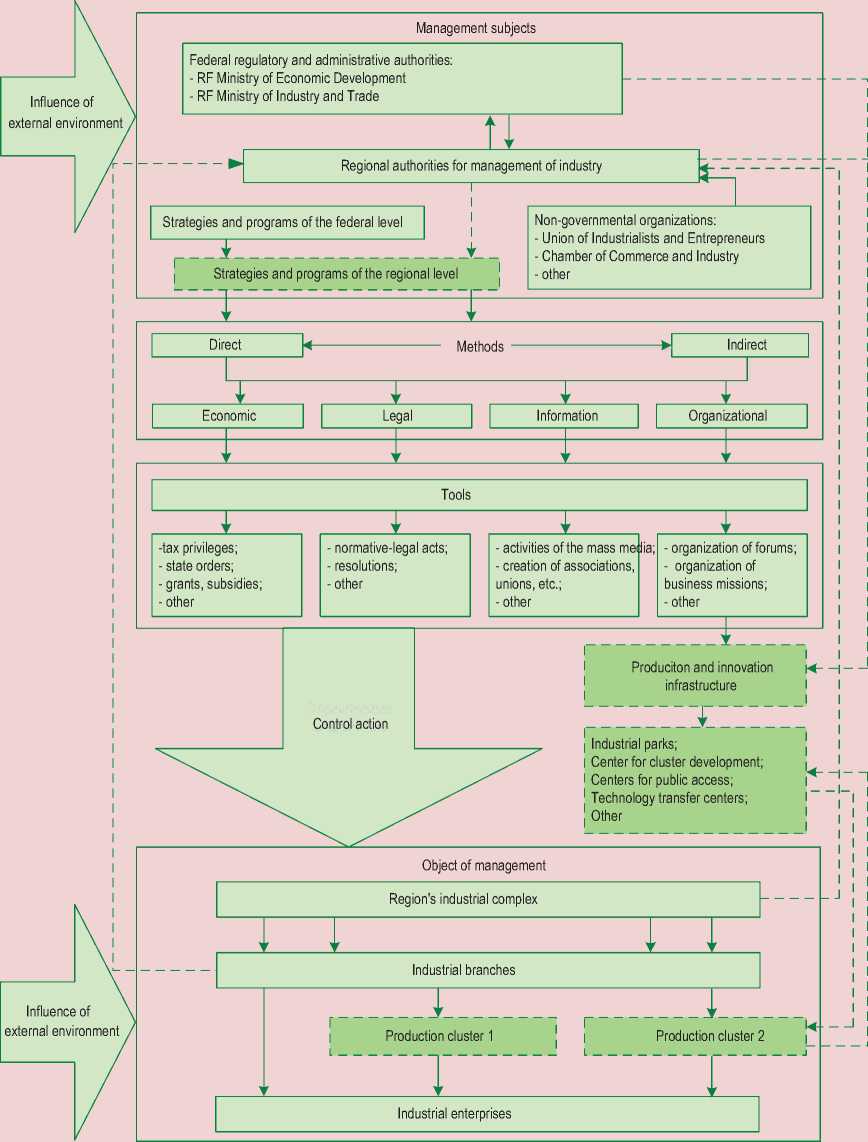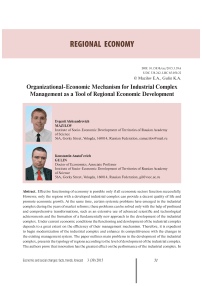Organizational-economic mechanism for industrial complex management as a tool of regional economic development
Автор: Mazilov Evgenii Aleksandrovich, Gulin Konstantin Anatolevich
Журнал: Economic and Social Changes: Facts, Trends, Forecast @volnc-esc-en
Рубрика: Regional economy
Статья в выпуске: 3 (39) т.8, 2015 года.
Бесплатный доступ
Effective functioning of economy is possible only if all economic sectors function successfully. However, only the regions with a developed industrial complex can provide a decent quality of life and promote economic growth. At the same time, certain systemic problems have emerged in the industrial complex during the years of market reforms; these problems can be solved only with the help of profound and comprehensive transformations, such as an extensive use of advanced scientific and technological achievements and the formation of a fundamentally new approach to the development of the industrial complex. Under current economic conditions the functioning and development of the industrial complex depends to a great extent on the efficiency of their management mechanism. Therefore, it is expedient to begin modernization of the industrial complex and enhance its competitiveness with the changes in the existing management system. The paper outlines main problems in the development of the industrial complex, presents the typology of regions according to the level of development of the industrial complex...
Region, industrial complex, organizational-economic mechanism, innovation activity, classification, mathematical modeling
Короткий адрес: https://sciup.org/147223736
IDR: 147223736 | УДК: 338.242 | DOI: 10.15838/esc/2015.3.39.6
Текст научной статьи Organizational-economic mechanism for industrial complex management as a tool of regional economic development
Industrial complex is the basis of Russia’s economy because it provides all economic sectors with the means of labor, ensuring economic security of the state and a decent standard of living. In 2013, manufacturing and mining enterprises and organizations, which produce and transmit electricity, gas and water, account for more than 32% of GDP (fig. 1). For nine years, since 2005, this indicator has not changed significantly, and it still holds a significant share in GDP.
However, recent crisis phenomena in the economy have had a significant impact on the volume of products shipped by industrial enterprises (fig. 2) . Thus, compared with 2005, manufacturing production in 2013 grew only by 29%, showing a significant drop
Figure 1. Structure of Russia’s GDP in 2005–2013, % [12, 13]

□ Agriculture, fishery □ Industry
□ Construction п Transport and communications
□ Trade □ Other
Figure 2. Dynamics of industrial production in the Russian Federation in 2005–2013 (2005 = 100), % [12, 13]

in 2009, and mining industry production grew by 14%. Production and distribution of electricity, gas and water remained at the level of 2005. For comparison: during this period the industry in China has grown by 2.4 times [9]. According to leading scientists [15], growth rate of industrial production in developed and newly industrialized countries reached 7–8.5% per year. Thus, we can say that Russian industrial complex is not developing actively enough.
The analysis of its structure shows that more than 65% of products is produced by manufacturing enterprises (tab. 1). In 2013, every fifth ruble of shipped products came from chemical production, production of coke and oil products, rubber and plastic products. At the same time, there is an upward trend in this industry: its share has increased by 4.6 percentage points (up to 21.5%) over the period under consideration.
Positive aspects include a slight growth (by 1.6 p.p.) in the production of machines, vehicles and equipment, electrical equipment, electronic and optical equipment – up to 14.6% in 2013. This indicator reaches 50% in the structure of industrial production in leading world economies. The share of machine building in China and France is 35–40% in the U.S. – 46%, in Japan and Germany – 51–54%) [8]. Thus, in general, the dynamics of values in Russia shows no deterioration in the structural proportions of industrial complex, but the main indicators
Table 1. Structure of Russian industrial complex in 2005–2013, %*
Note that main development indicators of industrial complex in 2005–2013 do not show any significant changes (tab. 2) . For instance, depreciation of fixed assets is still very high (45.7%). The number of employees at industrial enterprises has an insignificant but steady downward trend: their share in the total economically active population is only 17.3%, which is below the level of 2005 by 2.4 p.p.
The volume of investments in the fixed capital of industrial enterprises (calculated per enterprise) is one of the few indicators of growth. The indicator has increased by 8.7 million rubles over the analyzed period and reached 11.2 million rubles per industrial enterprise in 2013.
The level of innovation activity at the enterprises of industrial complex is about 10%, whish is much lower than in leading countries. For instance, in Germany the share of industrial organizations involved in innovative activities in the total number
Table 2. Key performance indicators of Russian industrial complex in 2005–2013*
In order to address the imbalances in the development of industrial complex, it is necessary to create conditions for active operation of new high-tech industries. This will increase the efficiency of industrial complex in general, and stimulate investment processes. The existing problems are largely systemic, many subjects of the Russian Federation face them. In this regard, the identification of general patterns and negative trends in their development and also the identification of leading regions is possible only on the basis of classification of subjects and their further grouping.
The present research into existing approaches to assessing the status and level of development of the region’s industrial complex [2, 3, 6, 11, 14] shows that they do not comply fully with criteria such as availability and objectivity of the source data; simplicity of calculations; representativeness of results; consideration of an innovative component of development; quantitative and qualitative indicators, which does not make it possible to assess adequately the condition of industrial complex in a given region.
Taking into consideration all of the above, we propose a methodology for assessing the level of development of industrial complex on the basis of calculation of the integral indicator based on the main factors of its development, quantitative and qualitative characteristics, taking into account the innovative aspect and performance results.
In accordance with the problem to be solved, the first stage was to develop a system of indicators for assessing the level of development of the regional industrial complex on the basis of an integrated approach. The system contains two blocks of indicators: factor indicators and resulting indicators. One block characterizes the main factors: main production assets, labor, investment and the use of innovation-technological resources in the manufacturing process. Another block shows performance results of industrial complex. We selected two types of indicators: quantitative and qualitative in order to assess each of the resources more objectively and comprehensively.
In the second stage we determined the index of the status of all the factors promoting industrial development that we selected and also industrial performance results; the index represents the mean square value of the standardized coefficients of the two constituent indicators.
In the third stage we formed the integrated indicator. In order to reflect the significance of each allocated block that characterizes the current state of the main factors promoting industrial development, it is reasonable to use the mean square value of the indices that are included in the integral indicator.
In the fourth stage we made the classification and correlation of the integral assessment of the state of industry in the regions by groups characterizing opportunities for the development of production. The threshold values of the integral assessment indicator are in the range from 0 to 1 (tab. 3). Thus, we can distinguish five levels of development of industry in the region.
It should be noted that the results obtained in the framework of this methodology can be used in the grouping of regions by level of industrial development, thereby creating their typology and distinguishing similar subjects.
The calculations show that in 2013 the Vologda Oblast was on the 9th place in the ranking of Russian regions by level of development of industrial complex (tab. 4) . The Sakhalin Oblast, Primorsky Krai, the Tyumen Oblast were leaders (through the implementation of major investment projects in the industry of the Far East, development of oil production, promotion of innovation processes in the regions) as well as Moscow (many enterprises located in other regions were registered there). The top ten also includes the Leningrad, Magadan, Kaluga, Kemerovo oblasts and Chukotka Autonomous Okrug.
The bottom ten regions include those with agricultural economy, and the regions of the North Caucasian Federal District.
Table 3. Classification of the integral assessment of the level of development of the region’s industry*
|
Interval No. |
Level of development of industry |
Interval borders |
|
1 |
High |
0.8 < I < 1.0 |
|
2 |
Above median |
0.6 < I < 0.8 |
|
3 |
Median |
0.4 < I < 0.6 |
|
4 |
Below median |
0.2 < I < 0.4 |
|
5 |
low |
0 < I < 0.2 |
|
* Compiled by the author. |
||
Table 4. Ranking of the Russian Federation subjects in terms of development of their industrial complex in 2013* (the top ten and bottom ten regions)
|
RF subject |
Ip |
Ranking position |
RF subject |
Ip |
Ranking position |
|
Sakhalin Oblast |
0.790 |
1 |
Astrakhan Oblast |
0.287 |
71 |
|
Primorsky Krai |
0.605 |
2 |
Kurgan Oblast |
0.287 |
72 |
|
Tyumen Oblast |
0.552 |
3 |
Republic of Adygea |
0.286 |
73 |
|
Moscow |
0.502 |
4 |
Chechen Republic |
0.282 |
74 |
|
Leningrad Oblast |
0.464 |
5 |
Krasnodar Krai |
0.264 |
75 |
|
Magadan Oblast |
0.461 |
6 |
Stavropol Krai |
0.249 |
76 |
|
Chukotka |
0.460 |
7 |
Jewish Autonomous Oblast |
0.220 |
77 |
|
Kaluga Oblast |
0.460 |
8 |
Republic of Ingushetia |
0.208 |
78 |
|
Vologda Oblast |
0.447 |
9 |
Republic of Dagestan |
0.202 |
79 |
|
Kemerovo Oblast |
0.443 |
10 |
Republic of North Ossetia–Alania |
0.197 |
80 |
|
* Calculated according to the data of the Federal State Statistics Service [12, 13]. |
|||||
Thus, according to the data obtained, in 2013 there were no regions that belonged to the group with a high level of industrial development, and only two regions belonged to the group with the value “above average”. The Vologda Oblast, along with 24 regions, had a “median” level of development of industrial complex.
Indicators calculated in the framework of the regions’ typology were used in a correlation analysis for determining the influence of the main factors promoting the development of industrial complex on the resulting factor. According to the analysis, the greatest impact on the state of industrial sector is caused by the innovation-and-technological factor (correlation coefficient is 0.446); this factor is followed by the labor resources factor (0.371), investment factor (0.305) and production (0.215) resources factor. The dependence was identified on the basis of analyzing the indicators chosen through the methodology of assessing the level of development of industrial complex for 2005–2013 in 80 subjects of the Russian Federation.
It is advisable to carry out mathematical modeling of innovation processes in order to assess the most important components of the innovation-and-technological factor. Based on the typology of Russian regions by level of development of industrial complex we selected 24 regions that belong to the same group as the Vologda Oblast. Next, we made an array of 41 indicators for 2005– 2013. Thus, the number of observations amounted to 225 units. Correlation analysis identified in the factors in this set that correlate to the greatest extent with the resulting indicator “the volume of shipped products by enterprises of the industry”. Having carried out the correlation and regression analysis and evaluation of multicollinearity of factor variables, we selected the most informative indicators, on the basis of which the regression equation was calculated (tab. 5) .
Table 5. Mathematical model and its characteristics
|
Factors |
Characteristic of mathematical model |
|
V = 171300.9 + 107.6 x X 1 + 32.5 x X 2 + 19.5 x X 3 + £ |
|
|
R correlation coefficient = 0.74 R determination coefficient = 0.561; Ftest (3,221) = 94.21; p- level < 0.00001. |
Validity of the obtained mathematical model is confirmed by the high value of correlation (0.74), the significant coefficient of determination (above 0.561), and the high F-test. The dependence revealed has allowed us to establish that the increase in the number of patents issued in Russia, the number of advanced production technologies, and the expenses on technological innovation have the greatest impact on the growth in the volume of shipped products of industrial enterprises. As a consequence, the implementation of activities contributing to the increase of these indicators, will contribute to the growth of the volume of shipped products. At that, the interaction of selected factors will help achieve maximum economic benefit from the resources expended.
It is possible to achieve the growth of the indicators listed above only if the approach to the management of regional industrial complex is improved.
The proposed structure of the organizational-economic mechanism of management is based on the system of management of the regional industrial complex, formed in the Vologda Oblast1; the system also provides for the adjustment of existing relationships and formation of new objects, subjects, methods and management tools (fig. 3). The presented mechanism is created and driven by regional governments, which are guided by their regional policy based on innovation development priorities, defined by the federal government and outlined in the basic documents on the country’s socio-economic development. At the same time, this management mechanism is based on the principles of regional governance, inherent functions, specifics of building intra-regional interaction, available resources and modern management technology.
The organizational-economic mechanism of the regional industrial complex management consists of three blocks.
The first block is a system that controls the operation of the region’s industrial complex. The block consists of state authorities that govern the activities of industrial complex, it also comprises public organizations and councils that govern the relationships between organizations within individual branches and carry out representational functions of business in the government and management authorities. In addition, the goal of this block is to shape the institutional framework promoting
Figure 3. Organizational-economic mechanism for the regional industrial complex management

► - missing connections II - missing objects innovation processes in the regional industrial complex. The block is based on the concept and strategy of development of industrial complex, sectoral policies, federal target programs, target regional and municipal programs and projects.
The second block, which represents a set of methods and tools, is fundamental in the management mechanism. Methods may vary depending on the assigned tasks, regional resource base, management practices and other aspects. As for the impact on the control object, methods that form the basis of the mechanism of industry management can be divided into direct and indirect ones, and by functional orientation they fall into the following groups: economic, legal, informational, and organizational. A wide range of methods allows for a differentiated approach to their choice depending on specific features of the stages of innovation development of industrial complex.
As for the other component of this block – a set of tools, their number and possible combinations – the degree of their use can vary depending on specific tasks, decisions and situations. Therefore, it is always necessary to consider a certain complexity of influence of different tools, the combination of which forms a comprehensive tool set of the mechanism. A set of concrete tools is constantly affected and undergoes changes under the influence of external and internal factors. At the same time, new tools emerge, and elements of the regional management system are improving (management authorities, structures, resources, technology, etc.).
It should be emphasized that the use of a number of methods cannot be predetermined and remain unchanged for different stages of transition to an innovative path in industrial complex, because, as it develops, these methods have to change (expediency of their application has to be revised). This, in turn, requires a flexible and mobile system to manage industry as a whole.
The third block represents the object of management. This includes both the region’s traditional industries and enterprises of its industrial complex, and industrial clusters recommended for construction.
In addition to the main blocks, the diagram (see fig. 3) reflects the processes of interaction and communication between individual components of the mechanism. Thus, first of all, it is necessary to restore the damaged connections between individual industries and management authorities. In addition, it is necessary to stimulate innovation processes, to build and improve production clusters and also the manufacturing and innovation infrastructure, which is one of the most effective tools in the development of these processes. And most importantly, it is necessary to enhance the development of relevant strategic documents.
In this regard, at the present stage of development of industrial complex in the Vologda Oblast the main goal can be the formation of a modern high-tech industrial complex on the basis of system modernization of existing resources, labor, manufacturing and innovative and
Figure 4. Areas of modernization of the Vologda Oblast industrial complex
Purpose – formation of a modern high-tech industrial complex on the basis of systemic modernization of existing resources, labor, manufacturing and innovative and technological potential. The complex should be able to increase gross regional product, meet the needs of the Oblast in the main types of competitive products, substantially increase inflows in the regional budget, significantly improve the quality of life of the population
|
Task 1: development of science-intensive industries at industrial enterprises of the region |
Task 2: development of industrial-innovative infrastructure |
Task 3: creatIon of conditions for the establishment of industrial clusters |
Task 4: attraction of investment in the industrial complex |
Task 5: development of human resources in the region’s industrial complex |
|||||
|
Areas of implementation |
|||||||||
|
1.Creation of the Fund for development of industrial technologies. 2. Promotion of activities of the Center for cluster development. 3. Establishment of industrial parks 4. Creation of centers for collective access to high-tech equipment. 5. Creation of import substitution centers. |
|
formation of the list of potential investors. |
1.Monitoring of the region’s need for professional personnel for the enterprises of the industrial complex. 2.Development and implementation of mechanisms for the attraction, support and retention of personnel in the enterprises of the industrial complex. 3.Restoration and development of the network of professional educational institutions. 4. Introduction of the regional order for training of specialists of higher qualification. |
|||||
technological potential. This industrial complex should be able to increase gross regional product twofold, to meet the needs of the Oblast in the main types of competitive products, to promote a substantial increase of the regional budget revenues, and to improve the quality of life of the population.
This goal can be achieved through the stage-by-stage development of industrial complex. In our opinion, it is expedient to distinguish two main stages of its modernization (fig. 4) .
The first stage involves the following tasks:
-
1. Development of science-intensive industries at industrial enterprises in the region.
-
2. Development of industrial infrastructure for attracting unique and progressive technology in industrial sector and promoting innovative products in the market.
-
3. Formation of conditions for creation of machine-building cluster.
-
4. Funding of industrial complex and attraction of investments there.
-
5. Development of human resources in industrial complex.
Successful implementation of the first stage will make it possible to stabilize the situation in the region, to create industrial clusters aimed at the production of new high-tech products.
In the framework of the second stage that is characterized by stable development of the region’s industrial complex and further growth of production efficiency, the vigorous development of high-tech industries and industrial clusters will continue, and innovative enterprises will be established. In addition, investment attractiveness of industry will increase, and regional production and innovation infrastructure will develop successfully.
The completion of the second stage will result in a steady increase in the efficiency of industrial production and competitiveness of products.
Implementation of these areas will promote the diversification of the structure of industrial complex and the development of technological capabilities in the region; all this will increase the competitiveness of regional economy. In addition, it will entail a growth in the pace of industrial production up to 7–8% per year by 2020 (to the level of developed and newly industrialized countries), and it will also increase the level of innovation activity at enterprises to 25–30% and the number of advanced production technologies as calculated per industrial enterprise up to 1–1.5 units.
Список литературы Organizational-economic mechanism for industrial complex management as a tool of regional economic development
- Mazilov E. A. Promyshlennaya politika kak mekhanizm regional'nogo razvitiya . Ekonomicheskie i sotsial'nye peremeny: fakty, tendentsii, prognoz , 2013, no. 1, pp. 187-194.
- Gribanova O.A., Moronova O.G. Ekonomika otrasli (mashinostroenie): uchebnoe posobie . Vologda: VoGTU, 2008. 143 p.
- Kalinina V.V. Sovremennye podkhody k otsenke promyshlennogo kompleksa regiona . //Vestnik Volgogradskogo gosudarstvennogo universiteta. Ser. 3, Ekon. Ekol. , 2011, no. 2 (19).
- Makoveev V.N. Zarubezhnyi opyt stanovleniya naukoemkikh proizvodstv . Vestnik ChGU , 2013, no. 3 (50), pp. 62-67.
- Makoveev V.N. Otsenka urovnya razvitiya innovatsionnoi deyatel'nosti v obrabatyvayushchei promyshlennosti regiona . Sovremennyi menedzhment: problemy i perspektivy: Materialy mezhdunarodnoi nauchno-prakticheskoi konferentsii 26 -27 marta 2015 g., g. Sankt-Peterburg . 2015. Pp. 334-337.
- Nazhmutdinov T.K. Otsenka effektivnosti funktsionirovaniya promyshlennogo kompleksa regiona v konkurentnoi srede . Audit i finansovyi analiz , 2007, no. 2. Available at: http://www.auditfin.com/fin/2007/2/Nagmutdinov/Nagmutdinov%20.pdf.
- Ofitsial'nyi sait Evrostata . Available at: http://epp.eurostat.ec.europa.eu.
- Petrov A.B. Postkrizisnye problemy razvitiya rossiiskogo mashinostroeniya . Problemy sovremennoi ekonomiki , 2011, no. 2 (38). Available at: http://www.m-economy.ru/art.php?nArtId=3631.
- Sait o mirovoi ekonomike, mirovykh tovarnykh i finansovykh rynkakh . Available at: http://www.ereport.ru/stat.php?razd el=country&count=china&table=ipecia
- Terebova S.V., Mazilov E.A. Issledovanie metodov povysheniya innovatsionnosti ekonomiki regiona: zaklyuchitel'nyi otchet o NIR . Vologda, 2014. 146 p.
- Satunina T.A. Sovershenstvovanie metodicheskogo instrumentariya otsenki effektivnosti promyshlennoi politiki v Rossiiskoi Federatsii . Sovremennye problemy nauki i obrazovaniya . 2014. Available at: http://www.science-education.ru/117-13606.
- Ofitsial'nyi sait Federal'noi sluzhby gosudarstvennoi statistiki . Available at: www.gks.ru.
- Edinaya mezhvedomstvennaya informatsionno-statisticheskaya sistema . Available at: www.fedstat.ru.
- Safina A.I. Metodika otsenki sotsial'no-ekonomicheskoi effektivnosti regional'noi promyshlennoi politiki . Ekspert , 2009, no. 14, pp. 32-37.
- Glaz'ev S.Yu. Strategiya operezhayushchego razvitiya Rossii v usloviyakh global'nogo krizisa . Moscow: Ekonomika, 2010. P. 103.


